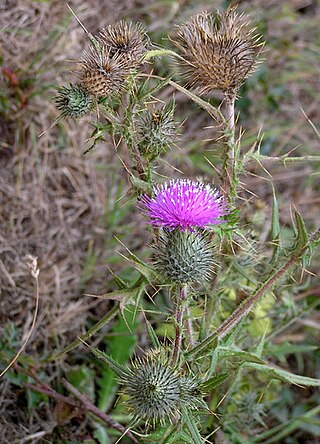
Cirsium is a genus of perennial and biennial flowering plants in the Asteraceae, one of several genera known commonly as thistles. They are more precisely known as plume thistles. These differ from other thistle genera in having feathered hairs to their achenes. The other genera have a pappus of simple unbranched hairs.

Cirsium vulgare, the spear thistle, bull thistle, or common thistle, is a species of the Asteraceae genus Cirsium, native throughout most of Europe, Western Asia, and northwestern Africa. It is also naturalised in North America, Africa, and Australia and is an invasive weed in some areas. It is the national flower of Scotland.

Cirsium arvense is a perennial species of flowering plant in the family Asteraceae, native throughout Europe and western Asia, northern Africa and widely introduced elsewhere. The standard English name in its native area is creeping thistle. It is also commonly known as Canada thistle and field thistle.

Thistle is the common name of a group of flowering plants characterised by leaves with sharp prickles on the margins, mostly in the family Asteraceae. Prickles can also occur all over the plant – on the stem and on the flat parts of the leaves. These prickles are an adaptation that protects the plant from being eaten by herbivores. Typically, an involucre with a clasping shape similar to a cup or urn subtends each of a thistle's flower heads. The typically feathery pappus of a ripe thistle flower is known as thistle-down.
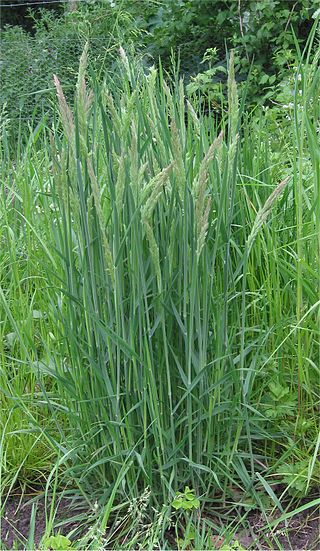
Holcus lanatus is a perennial flowering plant in the grass family Poaceae. The specific epithet lanatus is Latin for 'woolly' which describes the plant's hairy texture. Common names include Yorkshire fog, tufted grass, and meadow soft grass. In North America, where it is an invasive species, names include velvet grass and common velvet grass.
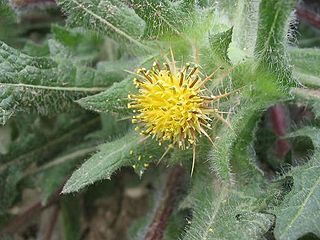
Centaurea benedicta, known by the common names St. Benedict's thistle, blessed thistle, holy thistle and spotted thistle, is a thistle-like plant in the family Asteraceae, native to the Mediterranean region, from Portugal north to southern France and east to Iran. It is known in other parts of the world, including parts of North America, as an introduced species and often a noxious weed.

Cirsium edule, the edible thistle or Indian thistle, is a species of thistle in the genus Cirsium, native to western North America from southeastern Alaska south through British Columbia to Washington and Oregon, and locally inland to Idaho. It is a larval host to the mylitta crescent and the painted lady.
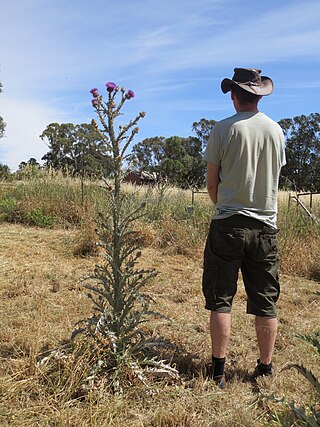
A noxious weed, harmful weed or injurious weed is a weed that has been designated by an agricultural or other governing authority as a plant that is injurious to agricultural or horticultural crops, natural habitats or ecosystems, or humans or livestock. Most noxious weeds have been introduced into an ecosystem by ignorance, mismanagement, or accident. Some noxious weeds are native. Typically they are plants that grow aggressively, multiply quickly without natural controls, and display adverse effects through contact or ingestion. Noxious weeds are a large problem in many parts of the world, greatly affecting areas of agriculture, forest management, nature reserves, parks and other open space.
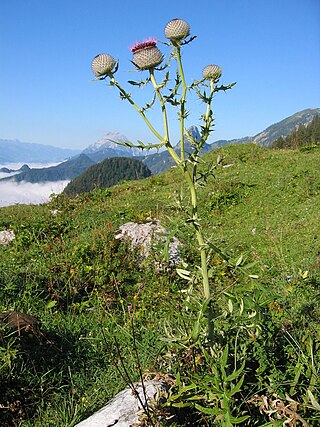
Cirsium eriophorum, the woolly thistle, is a herbaceous biennial species of flowering plant in the genus Cirsium of the family Asteraceae. It is widespread across much of Europe. It is a large biennial plant with sharp spines on the tips of the leaves, and long, woolly hairs on much of the foliage. The flower heads are large and nearly spherical, with spines on the outside and many purple disc florets but no ray florets.

Cirsium occidentale, with the common name cobweb thistle or cobwebby thistle, is a North American species of thistle in the family Asteraceae.

Cirsium discolor, the field thistle, is a North American species of plants in the tribe Cardueae within the family Asteraceae. It is native to thirty-three states in the United States as well four Canadian provinces. It occurs across much of eastern and central Canada as well as eastern and central United States. It has been found from New Brunswick west to Saskatchewan and south as far as Texas and Georgia.

Cirsium undulatum is a species of thistle known by the common names wavyleaf thistle and gray thistle. It is native to much of central and western North America from British Columbia east to Manitoba and south as far as the State of Durango in Mexico. It has also been found outside of its native range as an introduced species.
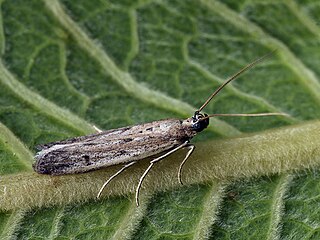
Homoeosoma nebulella, the Eurasian sunflower moth, is a moth of the family Pyralidae. It is found in Europe, Russia, Anatolia, the Middle East and West Africa. The wingspan is 20–27 mm.

Cirsium vinaceum is a rare species of thistle known by the common name Sacramento Mountains thistle. It is endemic to Otero County, New Mexico, in the United States, where it is known only from the Sacramento Mountains. The plant can be found in six canyon systems in a southern section of this mountain range spanning about 32 kilometers. It is rare because it is limited to a specific type of mountain wetland which is both naturally uncommon and threatened by a number of forces. The plant was federally listed as threatened in 1987.
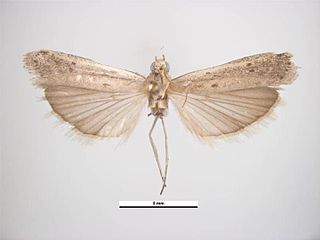
Homoeosoma electellum, the American sunflower moth, is a species of moth of the family Pyralidae. It is native to North America but also found in South America. Its larvae eat the flowers and developing seeds of many asters, including echinacea.

Cirsium muticum, also known as swamp thistle, marsh thistle, dunce-nettle, or horsetops, is a North American species of plants in the family Asteraceae, native to central and eastern Canada and the central and eastern United States.
Cirsium ownbeyi, or Ownbey's thistle, is a rare North American species of flowering plant in the family Asteraceaey. It is endemic to the United States, where it has a narrow distribution in northeast Utah, southwest Wyoming, and northwest Colorado. There are around 30 known populations with a total of approximately 25,000 individuals.

Cirsium eatonii, commonly known as Eaton's thistle or mountaintop thistle, is a North American species of flowering plants in the family Asteraceae.
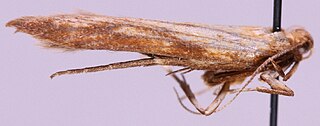
Metzneria neuropterella, the brown-veined neb, is a moth of the family Gelechiidae. It is found from most of Europe to the southern Ural Mountains, the Caucasus, southern and south-eastern Siberia and Mongolia, as well as in North Africa. The habitat consist of short-turfed, herb rich chalk downland.

Cirsium altissimum is a North American species of plants in the tribe Cardueae within the family Asteraceae. Common names are tall thistle or roadside thistle. The species is native to the eastern and Central United States.



















